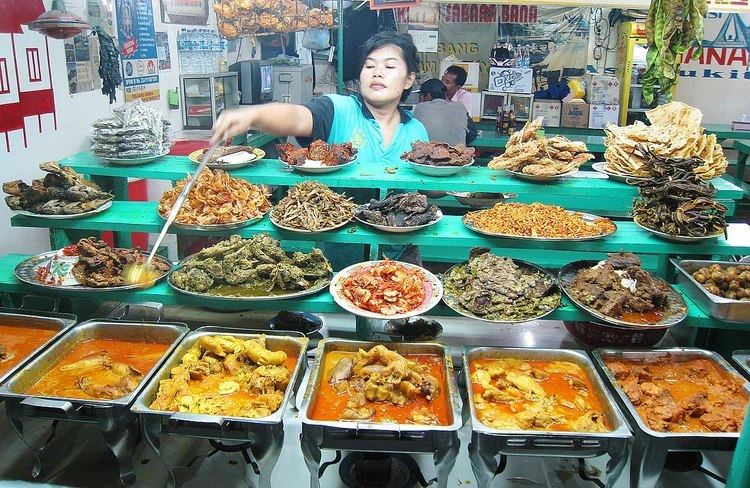 | ||
Padang food is the cuisine of the Minangkabau people of West Sumatra, Indonesia. It is among the most popular food in Maritime Southeast Asia. It is known across Indonesia as Masakan Padang (Padang cuisine, in English usually the simpler Padang food) after the city of Padang the capital city of West Sumatra province. It is served in restaurants mostly owned by perantauan (migrating) Minangkabau people in Indonesian cities. Padang food is ubiquitous in Indonesian cities and is popular in neighboring Malaysia and Singapore. The term "Padang food" is often used to designate the whole culinary traditions of Minangkabau people. However, this term is seldom used in Minangkabau inland cities such as Bukittinggi — a culinary hotspot in West Sumatra where they refer to it as Masakan Minang or Minangkabau food, since there are differences between Nasi Padang of Padang and Nasi kapau of Bukittinggi.
Contents
Padang food is famous for its rich taste of succulent coconut milk and spicy chili. Minang cuisine put much emphasis in three elements; gulai (curry), lado (chili pepper) and bareh (rice). No traditional Padang meal is complete without the three — spicy chili sauce; thick curry and perfect steamed rice. Among the cooking traditions in Indonesian cuisine, Minangkabau cuisine and most of Sumatran cuisine, demonstrate Indian and Middle Eastern influences, with dishes cooked in curry sauce with coconut milk and the heavy use of spices mixture.
Because most Minangkabau people are Muslims, Minangkabau cuisine follows halal dietary law rigorously. Protein intake are mostly taken from beef, water buffalo, goat, lamb meat, and poultry and fish. Minangkabau people are known for their fondness of cattle meat products including offal. Almost all the parts of a cattle, such as meat, ribs, tongue, tail, liver, tripe, brain, bone marrow, spleen, intestine, cartilage, tendon, and skin are made to be Minangkabau delicacies. Seafood is popular in coastal West Sumatran cities, and most are grilled or fried with spicy chili sauce or in curry gravy. Fish, shrimp, and cuttlefish are cooked in similar fashion. Most of Minangkabau food is eaten with hot steamed rice or compressed rice such as katupek (ketupat). Vegetables are mostly boiled such as boiled cassava leaf, or simmered in thin curry as side dishes, such as gulai of young jackfruit or cabbages.
Padang restaurants
In Padang food establishments, it is common to eat with one's hands. They usually provide kobokan, a bowl of tap water with a slice of lime in it to give a fresh scent. This water is used to wash one's hands before and after eating. If a customer does not wish to eat with bare hands, it is acceptable to ask for a spoon and fork.
The cuisine is usually cooked once per day. To have Nasi Padang in restaurants customers choose from those dishes, which are left on display in high-stacked plates in the windows. During a dine-in hidang (serve) style Padang restaurant, after the customers are seated, they do not have to order. The waiter immediately serves the dishes directly to the table, and the table will quickly be set with dozens of small dishes filled with highly flavored foods such as beef rendang, curried fish, stewed greens, chili eggplant, curried beef liver, tripe, intestines, or foot tendons, fried beef lung, fried chicken, and of course, sambal, the spicy sauces ubiquitous at Indonesian tables. Customers take — and pay for — only what they want from this array. The best known Padang dish is rendang, a spicy meat stew. Soto Padang (crispy beef in spicy soup) is local residents' breakfast favorite, meanwhile sate (beef satay in curry sauce served with ketupat) is a treat in the evening.
The serving style is different in Nasi Kapau food stalls, a Minangkabau Bukittinggi style. After the customer is seated, he or she is asked which dishes they desire. The chosen dishes will be put directly upon the steamed rice or in separate small plates.
There are myriad Padang food establishments throughout Indonesia and the region, according to Ikatan Warung Padang Indonesia (Iwapin) or Warung Padang Bonds. In greater Jakarta alone there are at least 20,000 Padang restaurant establishments. Several notable Minangkabau restaurant chains are Sederhana, Garuda, Pagi Sore, Simpang Raya, Sari Ratu, Sari Minang, Salero Bagindo and Natrabu.
The importance of Padang food establishments (warung or rumah makan Padang) for Indonesian workers' lunch break in urban areas, was demonstrated in 2016; when Jakarta municipal civil servants demanded the raise of uang lauk pauk (food allowance, as a component of civil servant's salary), following the raise of Nasi Padang price in Greater Jakarta area.
Dishes
The cooking method of gulai, which employing certain ingredients; meat, poultry, vegetables, fish or seafood simmered and slowly cooked in coconut milk, spice mixture and chili pepper, formed the backbone of Minangkabau cooking tradition. The thick golden, yellowish, succulent and spicy gulai sauce has become the hallmark of Padang restaurant's window display everywhere. In Padang, smart cooking means the capability of preparing gulai. Randang (beef simmered in coconut milk and spices), asam padeh (sour and spicy stew) and kalio (watery and light-colored gravy) are just a few variations of Padang gulai.
